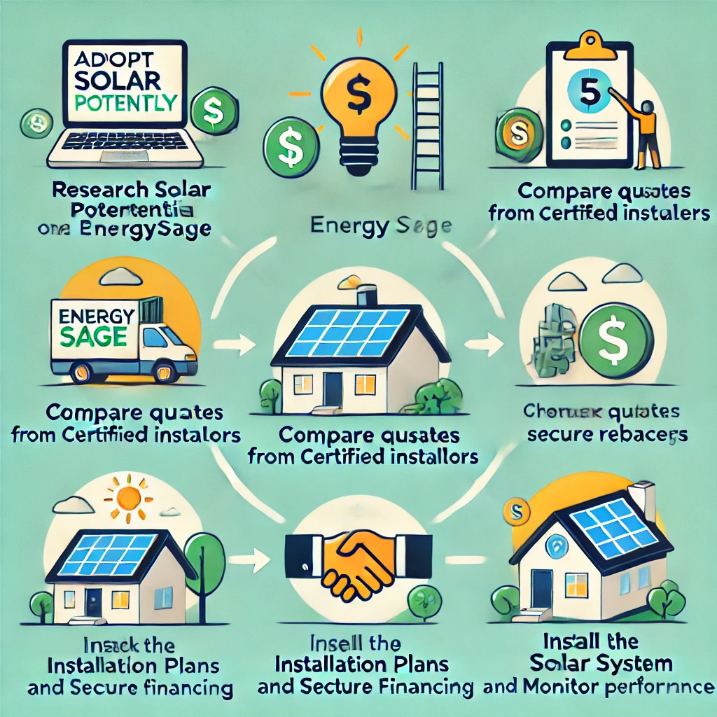How Digital Platforms Support Renewable Energy Adoption
Renewable Energy ?? Comments 30/Sep/2025 TueDigital platforms are revolutionizing renewable energy adoption by providing households with easy access to information, tools, and resources. Platforms like Solar.com and EnergySage streamline decision-making, allowing users to compare solar installers, financing options, and potential savings. By simplifying the complexities of renewable energy adoption, these platforms empower residents to make informed and confident choices.
Details
-
How Digital Platforms Facilitate Renewable Energy Adoption
- Comparison of Solar Installers:
Platforms like EnergySage and Solar.com allow users to compare multiple solar installers in their area based on factors such as cost, customer reviews, and system warranties.
-
These platforms often feature pre-vetted, certified installers, ensuring high-quality service and reliability.
-
By providing side-by-side comparisons, users can evaluate options and select the installer that best suits their budget and energy needs.
-
Financing Options and Incentives:
Digital platforms help users explore a variety of financing options, including solar loans, leases, and power purchase agreements (PPAs).
-
Platforms also highlight federal, state, and local incentives, such as the federal solar tax credit (30% of installation costs) or state-specific rebates and property tax exemptions.
-
EnergySage, for instance, offers a Solar Financing Marketplace, where users can compare loan offers from multiple lenders.
-
Customized Savings Estimates: Tools provided by these platforms use data such as a home’s location, energy usage, and roof characteristics to generate detailed savings estimates.
-
For example, EnergySage offers a Solar Savings Calculator that predicts the financial benefits of installing solar panels, including payback periods and lifetime savings.
-
Solar.com provides similar tools, along with insights into the environmental benefits of solar adoption, such as the reduction in carbon emissions.
-
Additional Features of Digital Platforms
-
Educational Resources: Many platforms offer detailed guides, FAQs, and blogs to educate users about the solar installation process, system options, and benefits of renewable energy.
-
Transparency and Confidence: By offering transparent pricing, reviews, and detailed comparisons, these platforms help users avoid overpaying or encountering unreliable service providers.
-
Support for the Entire Process: From initial research to installation and beyond, platforms like EnergySage provide end-to-end support, ensuring a seamless transition to renewable energy.
-
Practical Example
Using EnergySage to Adopt Solar Panels
-
A homeowner in California decides to explore solar energy but is unsure where to start. They visit EnergySage and follow these steps:
-
Calculate Costs and Savings: The homeowner uses EnergySage’s Solar Savings Calculator, which estimates their potential costs and savings based on their monthly electricity bill, roof orientation, and state incentives. The tool shows that they could save $20,000 over 25 years by going solar.
-
Find Financing Options: The homeowner accesses EnergySage’s Solar Financing Marketplace to compare loan offers. They choose a 10-year solar loan with a competitive interest rate, enabling them to avoid upfront costs while benefiting from immediate energy savings.
-
Compare Installers: EnergySage provides quotes from multiple certified solar installers, including pricing, equipment options, and customer reviews. The homeowner selects a local installer with excellent ratings and a 25-year warranty.
-
Access Incentives: The platform highlights relevant incentives, such as the federal solar tax credit and a California state rebate, reducing the overall project cost by 35%.
-
Hire a Certified Installer: After reviewing the quotes, the homeowner hires a certified installer directly through the platform, ensuring high-quality service and adherence to best practices.
Outcome:
The homeowner successfully installs a solar system that reduces their electricity bill by 80%, recovers their investment within seven years, and contributes to significant carbon emissions reductions.
Key Benefits of Digital Platforms for Renewable Energy Adoption
-
Simplified Decision-Making: Platforms like Solar.com and EnergySage remove the guesswork by offering clear, comparable information about solar options, financing, and installers.
-
Cost Transparency: By providing multiple quotes and financing options, these platforms ensure users can make cost-effective decisions without overpaying.
-
Access to Incentives: Digital tools identify and integrate all available incentives, maximizing affordability and reducing upfront costs.
-
Time Efficiency: Instead of contacting multiple installers or researching financing options independently, users can access all necessary information in one place.
-
Environmental Impact: By facilitating the adoption of renewable energy, these platforms contribute to reduced reliance on fossil fuels and lower greenhouse gas emissions.
-
Confidence and Trust: Platforms that offer reviews, certifications, and warranties help users feel confident in their decisions, reducing concerns about service quality or hidden costs.
By leveraging digital platforms like EnergySage and Solar.com, households can navigate the complexities of renewable energy adoption with ease, achieving significant financial and environmental benefits.
Infographic: Steps to Adopt Solar Through a Digital Platform
-
Research solar potential using digital platforms like EnergySage.
-
Compare quotes from certified solar installers.
-
Check eligibility for tax credits and state rebates.
-
Finalize installation plans and secure financing.
-
Install the solar system and monitor performance.

Tags: renewable energy digital platforms solar